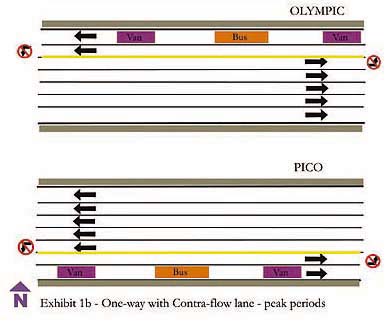|
By Ann K. Williams
Staff Writer
July 15 -- A plan to free up Westside traffic by
turning Olympic and Pico boulevards into one-way streets met
with skepticism at a meeting at Ken Edwards Center last week.
Under the plan, most lanes on Pico would be westbound, while
most on Olympic would go east, forming a loop from the beach
to downtown Los Angeles. During rush hours, parking would
be prohibited while two “contra-flow” lanes would
be open to emergency vehicles and buses on each street to
go in the opposite direction of prevailing traffic.
 |
| Drawings courtesy of Allyn D. Rifkin,
P.E., Transportation Planner/Engineer |
The proposal -- discussed at a meeting Thursday -- is the
latest idea from County Supervisor Zev Yaroslavsky, who says
cheap short-term traffic solutions are needed because more
expensive subway and light rail projects are likely many years
away.
Outlining the idea Thursday night, Allyn Rifkin -- a transportation
consultant working for Yarolsavksy -- said the plan was a
starting point for discussion.
“This is an opportunity for people to say things,”
Rifkin said. “This is a first step, hearing different
thoughts and ideas.”
But the crowd of 50 or so Santa Monicans seemed wary of the
idea.
Many of their comments reflected concerns raised during the
City’s Land Use and Circulation Elements (LUCE) community
discussions of the past two years.
The LUCE discussions seem to have favored a pedestrian-and-bike-friendly
city with small neighborhood business centers catering to
local residents.
Several residents pointed out that Santa Monica is the only
city in which the 10 Freeway divides Olympic and Pico Boulevards.
The freeway limits north-south access between the boulevards.
“The freeway is like a giant river cutting our city
in half,” Sunset Park resident Charles Donaldson said.
“All of these little streets cut off north of Pico.”
Commuters use Pearl Street, Walgrove and other Sunset Park
residential streets to get to the freeway, said Donaldson.
“All of these jam up and they dump out on Pico,”
he said.
And the stretch along Santa Monica College would be hit hard,
Donaldson added. “One lane going west would be blocked
with cars trying to get into college parking lots.”
One resident said that parking, already scarce, would be
harder to find on Pico Boulevard, which is currently home
to many small businesses that cater to the surrounding neighborhoods.
One-way traffic would make it harder to get to those businesses,
especially during peak hours.
Another resident pointed out that Santa Monica High School,
Santa Monica College and the Water Garden are located on these
boulevards, and eliminating two-way traffic would worsen the
already-heavy traffic leading to and from the high-density
destinations.
Other residents said:
“If all the traffic comes into Santa Monica on Pico,
how does it get absorbed?
“What would happen to the recently installed medians
and streetscaping on Pico? What about the medians on Olympic?”
“If the goal is mass transit, why are we accommodating
single vehicle drivers?”
“This is a benefit for the commuters…this is
not a benefit for Santa Monica. It will increase people coming
down from the Valley.”
Can we “leave Santa Monica out of it, loop at Pico?”
“Is there any citizen that you’ve met with that’s
in favor of this project?”
At this point, Rifkin said that generally people who live
near the boulevards have more concerns than others. As a planner,
he isn’t invested in any one particular outcome, he
said.
“This is the beginning of a discussion,” Rifkin
said. “I’m interested in the process of people
discussing this.”
“We’ve been meeting with the community groups
from one end of Pico and Olympic to the other," he said.
Rifkin has met with groups in Los Angeles, Culver City, Beverly
Hills and, now, Santa Monica.
Yaroslavsky’s idea came to him as the Supervisor spent
nearly an hour trying to get from Cloverfield Boulevard near
Michigan Avenue to the 405 Freeway one evening at rush hour,
according to press reports.
Even before this epiphany, Yaroslavsky was on record emphasizing
the need for immediate action to get Westside traffic moving.
(see
story)
At a meeting with Westside leaders in 2005, Yaroslavsky advocated
for “bit-by-bit solutions” to get the Westside
moving “here and now.”
We can’t wait for “something that takes 25 years
to build,” he said.
A description of a preliminary proposal was contained in
a written recommendation authored by Rifkin and passed out
at the meeting. It discusses “the feasibility of converting
Olympic and Pico Boulevards into a one-way pair between the
City of Santa Monica and Downtown Los Angeles Central Business
District.”
According to Rifkin’s abstract, during non-rush hours,
each boulevard would have parking lanes on both sides of the
street and a “contra-flow” lane for traffic going
the other way.
During rush hours, parking would be prohibited, opening up
one more lane going the dominant direction and one more “contra-flow”
lane. During rush hours, only vans, buses and emergency vehicles
would be allowed to use the “contra-flow” lanes.
While the boulevards in the City of Los Angeles would have
seven lanes, five one way and two “contra” during
rush hour, Rifkin acknowledged there wouldn’t be enough
room for that configuration in Santa Monica.
Rifkin also handed out a sheet of key features at the meeting.
(see
document)
“This approach has the potential for…as much
as 20.5 percent increase of vehicle capacity,” according
to Rifkin, who also said this plan would cost in “the
10’s of millions compared with the 100’s of millions”
for other traffic solutions.
City staff will prepare an informational report for the City
Council, City Transportation Manager Lucy Dyke said. It will
likely be on the agenda this fall.
“The LUCE will be the basis of making policy recommendation,”
Dyke added later. “Our policies will continue to frame
our choices.”
“We think of our streets not as conduits for cars but
as places,” said Dyke. |